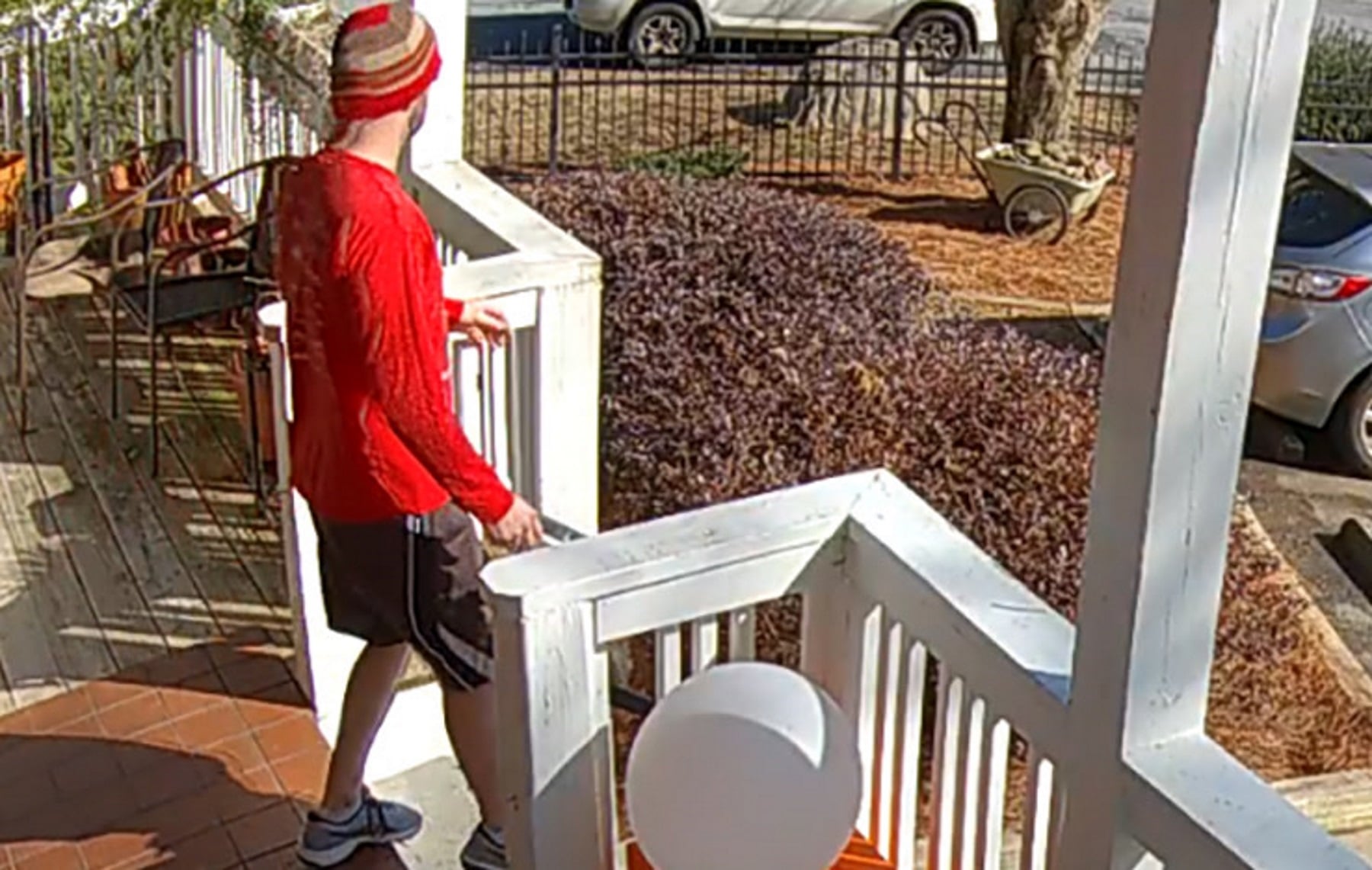Bystanders Who Perform CPR Exponentially Increase Survival Rates – One Atlanta Man Knows

A neighbor’s Nest security camera records Matthew Jadlocki as he leaves for a run through the Morningside neighborhood. Minutes after this image was captured, the 36-year-old teacher went into cardiac arrest. The security camera footage helped police and Jadlocki’s family trace him to Emory University Hospital, where he’d been admitted as a “John Doe.”
(Jim Burress/WABE)
Any morning you awake to two police cars outside your bedroom window, it’s safe to say something is wrong.
That’s how the morning of Wednesday, Jan.30 began for me.
An Atlanta Police Department patrol officer was speaking to a woman I’d never seen before. They kept going in and out of Matt’s (my upstairs neighbor’s) condo. Turns out it’s Matt’s sister. And although Matt’s skeptical Jack Russell terrier named Stella was home, Matt was not.
“So we have upgraded the previous watch area into different zones of a winter storm warning,” a matter-of-fact voice says through my NOAA weather radio.
If you don’t remember, this was the time of the Great Pre-Super Bowl Snowstorm. If you believed the forecast, we were in for it.
Schools canceled classes. Matt, a teacher in his mid-30s, took advantage of the unexpected free time to go for a run.
So how is it I know that titbit, but the police, his sister — and seemingly no one else — did?
My security camera.
It silently recorded Matt leaving at exactly 2:07 p.m. the previous day. He’d prepared for the cold by wearing a red, long-sleeve T-shirt. Grey shorts, Asics running shoes. A headband protected his ears.
Before disappearing from the camera’s gaze, Matt pauses, glances around and, without any fanfare, vanishes from view.
About that time, Ken Rodriguez was in his car on his way to work. And if the name sounds familiar, it’s because he’s that Ken Rodriguez, the sports anchor at WAGA-TV Fox 5. Along his commute to the station, he notices Matthew — first as just another runner on the sidewalk.
But then, after “another quick glance, I noticed he was stumbling, almost like his battery power was running out.” Rodriguez says.

He describes the man as moving in slow motion and “just collapsed chin-first behind some bushes on the sidewalk.”
“And in a split second I felt like he was in trouble and knew nobody would find him. It was a freezing cold day. Nobody was out.”
Rodriguez ran over to him while dialing 911.
“As I was walking over to him and he was facing down. His eyeglasses or sunglasses and hat were still on. He was breathing heavy. And then I told the operator he’s stopped breathing. His eyes were fixed and dilated. Let’s face it. He was dead,” says Rodriguez.
911 EMS: What’s the address of your emergency.
Rodriguez: I just pulled over on the side of the road. East Rock… Please hurry. He is turning colors now.
911: All right. Tell me exactly…
Rodriguez: He looks unconscious. Looks like blood … Please tell me you’ve sent somebody.
911: Is he breathing completely normal?
Rodriguez: Not at all. He almost seems like he’s stopped right now. I began doing compressions. (“Hang in there, man,” he says away from the phone.)
“I remember what my son who is a doctor had told me … ‘Stayin’ Alive’ … It’s the Bee Gees’ ‘Stayin’ Alive!’ That’s the beat you need to keep,” Rodriguez said. “And you’re supposed to do it hard. I kept it going, and sure enough, the most amazing thing. I don’t think I’d even broken a sweat yet. And the EMS personnel arrive.”
“There was a note that came out, and I clearly remember this because I was driving,” says Stephen Woolfitt, an advanced EMT who responded to the call. “It said ‘turning blue’ in the notes, and we know when somebody is turning blue that they’re not getting enough oxygen. So I immediately started driving with lights and sirens, and I probably drove much, much faster than I should have. A couple seconds after that, we got the note that CPR was in progress. So we knew this was a legitimate cardiac arrest. So it was…”
“It was all perfectly chaotic,” says Kendal Krueger, a paramedic with Grady Ambulance.
“We knew it was real, well before we got there,” Woolfitt adds. “And we got there in about two to three minutes.”
“Well first I saw Ken doing CPR. So immediately I had him stop to check to see if he had a pulse. And I heard him. He was agonal breathing. He’s gasping breath when someone’s not … when the heart … It’s his body’s last response of trying to breathe, and he didn’t have a pulse. I started CPR as my partner, and another rider we had, was getting all the equipment,” recounts Krueger.
“She got a pulse. They loaded on the lift. And then I jumped in my car and ran to work,” Rodriguez says.
The first responders then took Matthew to the care of Dr. Michael Carr, an emergency physician at Emory University Hospital.
Dr. Carr knew Matthew Jadlocki had the cards stacked against him, but because Ken Rodriguez immediately administered CPR, Carr had reason to be optimistic.
“So unfortunately, most of the cardiac arrests that we see coming in from the outside are … Read More
“So unfortunately, most of the cardiac arrests that we see coming in from the outside are not surviving. So things that we’re listening out for on the radio, when they’re coming in, they’re saying this was a witness cardiac arrest. They had early chest compressions by a bystander, those are all good prognostic indicators where we’d say, this patient has a lot higher chance of surviving.” — Dr. Michael Carr
“Most cardiac arrests’ out-of-hospital survival rates is about 9% — 9% to 12%. So unfortunately, most of the cardiac arrests that we see coming in from the outside are not surviving,” says Carr.
But he recalls some good “things that we’re listening out for on the radio, when they’re coming in. They’re saying this was a witness cardiac arrest. They had early chest compressions by a bystander. Those are all good prognostic indicators where we’d say, this patient has a lot higher chance of surviving,” Carr says.
Matthew Jadlocki had gone for a run and not brought his wallet. So he came into the emergency department as a “John Doe,” Carr remembers.
“We didn’t know who he was.”
“And we rolled him back into the resuscitation bay of the emergency department. And on our first, what we call a pulse check, he had already returned his pulses. He had return of spontaneous circulation, and Matthew went to the ICU. And slowly over the next few days started to regain consciousness. Over the next week to 10 days, he significantly improved and was ultimately discharged from the hospital,” Carr says.
“Learn CPR,” Jadlocki says emphatically.
“And in talking with Ken, he actually may have been trained years and years ago, but he hasn’t had recent training. He just kind of has this knowledge about the ‘Stayin’ Alive’ song. And that’s part of what got him through it,” Jadlocki says about Rodriguez.
But it’s also “having the wherewithal to stay calm and listen to the directions of the 911 operator,” Jadlocki adds. “That was huge. So a combination of having some knowledge but also being able to stay calm in that situation. It’s incredibly important, and I am forever grateful that [Ken Rodriguez] was there.”
“I encourage anybody who’s out there, get trained in CPR,” Jadlocki says, fully aware of his bias.
“I’ve been trained in CPR previously,” he says, singing in a falsetto, ‘ah, ah, ah, ah, stayin’ alive’ so that I can have that rhythm in case I need to use CPR at some point.”








